最新PEP小学英语六年级上册知识点归纳
最新人教版PEP英语六年级上册知识点归纳
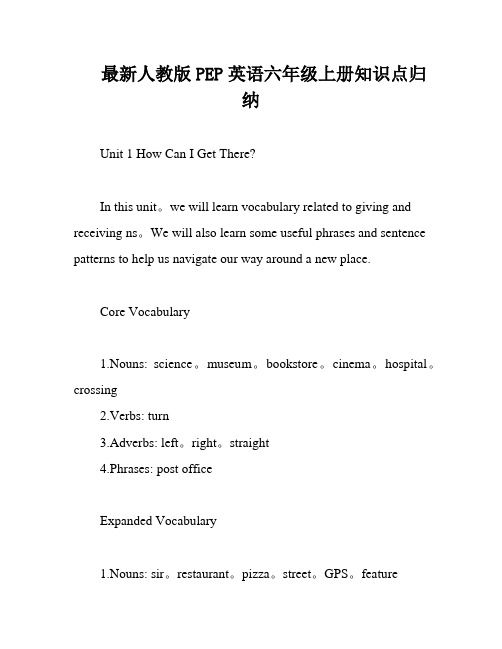
最新人教版PEP英语六年级上册知识点归纳Unit 1 How Can I Get There?In this unit。
we will learn vocabulary related to giving and receiving ns。
We will also learn some useful phrases and sentence patterns to help us navigate our way around a new place.Core Vocabulary1.Nouns: science。
museum。
bookstore。
cinema。
hospital。
crossing2.Verbs: turn3.Adverbs: left。
right。
straight4.Phrases: post officeExpanded Vocabulary1.Nouns: sir。
restaurant。
pizza。
street。
GPS。
feature2.Verbs: ask。
get。
gave。
follow。
tell3.Adjectives: interesting。
Italian。
farSentence Patterns1."Where is the ____?" - "It's next to the ____."2."How can we get there?"3."Turn left/right at the _____。
Then turn left/right at the _____."Note: Be mindful of ns and their fixed phrases.Useful Phrases1."Is there a ____?"2."There is a ____ under the ____."3."There be" sentence pattern - "There is/are ____." (Remember the principle of proximity.)By learning and practicing these vocabulary words。
人教版PEP三起小学英语六年级上册知识点总结

人教版PEP三起小学英语六年级上册知识点总结Unit1 How can I get there?一、重点单词和短语Science科学museum博物馆post office邮局bookstore书店cinema电影院hospital医院tasty美味的,可口的London Eye伦敦眼stomach胃crossing十字路口turn left/turn right向左/右转go straight=walk straight直走next to紧挨着/与……相邻far from(离……远)near在……附近behind(在……后面)in front of(在……前面)between…and…(在…和…之间)二、重点句子1.How do you go to school? 你是怎样去上学的?2.where is the restaurant? 餐馆在哪里?3. Usually I go to school on foot. 我通常走路去上学。
4. Sometimes I go by bike. 有时候我骑自行车去。
5.问路之前,出于礼貌,我们要说“Excuse me”与后面的句子要用标点符号隔开。
6.Look at the traffic lights, remember the traffic rules. 看着交通灯,记住交通规则。
7.Stop at a red light.Wait at a yellow light. Go at a green light.红灯停。
黄灯等一等。
绿灯行。
8.Red means stop, yellow means wait, green means go. 红色的意思是停止,黄色的意思是等待,绿色的意思是通行。
9.How can I get to the park? 我该怎样到达公园呢?10.You can go by the No.15 bus. 你可以坐15路公交车去。
新版PEP小学英语六年级上册1-6单元知识点总结
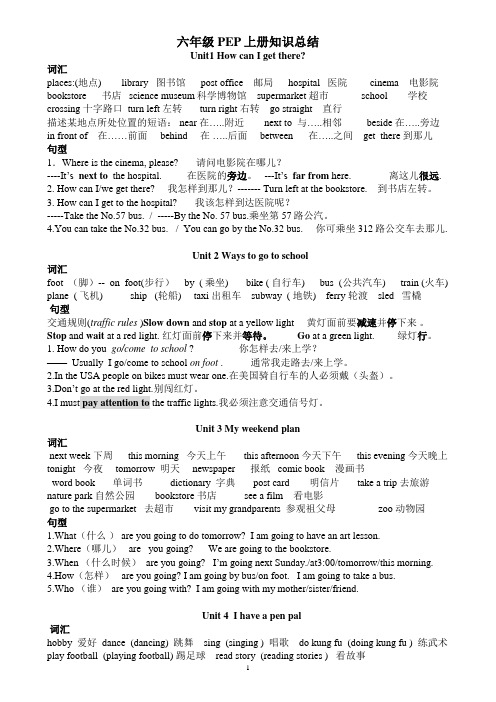
六年级PEP上册知识总结Unit1 How can I get there?词汇places:(地点) library 图书馆 post office 邮局 hospital 医院 cinema 电影院bookstore 书店 science museum科学博物馆 supermarket 超市 school 学校crossing 十字路口 turn left 左转 turn right 右转 go straight 直行描述某地点所处位置的短语: near 在…..附近 next to 与…..相邻 beside 在…..旁边in front of 在……前面 behind 在…..后面 between 在…..之间 get there 到那儿句型1.Where is the cinema, please? 请问电影院在哪儿?----It’s next to the hospital. 在医院的旁边。
---It’s far from here. 离这儿很远.2. How can I/we get there? 我怎样到那儿?------- Turn left at the bookstore. 到书店左转。
3. How can I get to the hospital? 我该怎样到达医院呢?-----Take the No.57 bus. / -----By the No. 57 bus.乘坐第57路公汽。
4.You can take the No.32 bus. / You can go by the No.32 bus. 你可乘坐312路公交车去那儿.Unit 2 Ways to go to school词汇foot (脚)-- on foot(步行) by ( 乘坐) bike ( 自行车) bus (公共汽车) train (火车) plane ( 飞机) ship (轮船) taxi 出租车 subway ( 地铁) ferry 轮渡 sled 雪橇句型交通规则(traffic rules )Slow down and stop at a yellow light 黄灯面前要减速并停下来。
新版pep六年级上册英语各单元知识点总结
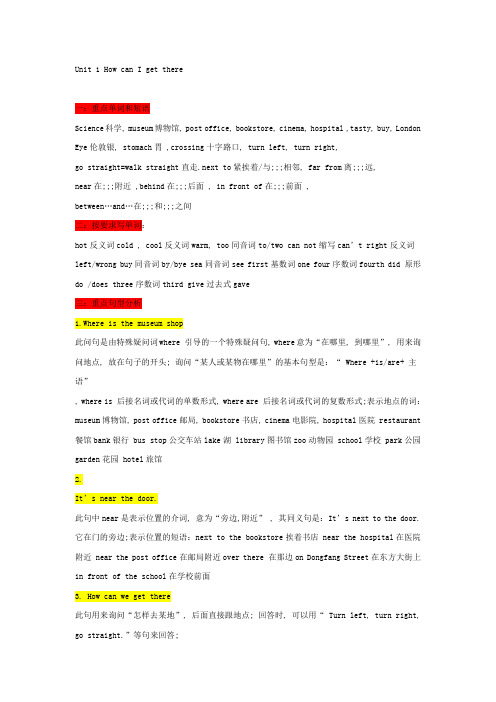
Unit 1 How can I get there一:重点单词和短语Science科学, museum博物馆, post office, bookstore, cinema, hospital ,tasty, buy, London Eye伦敦银, stomach胃 ,crossing十字路口, turn left, turn right,go straight=walk straight直走.next to紧挨着/与;;;相邻, far from离;;;远,near在;;;附近 ,behind在;;;后面 , in front of在;;;前面 ,between…and…在;;;和;;;之间二:按要求写单词:hot反义词cold , cool反义词warm, too同音词to/two can not缩写can’t right反义词left/wrong buy同音词by/bye sea同音词see first基数词one four序数词fourth did 原形do /does three序数词third give过去式gave三:重点句型分析1.Where is the museum shop此问句是由特殊疑问词where 引导的一个特殊疑问句, where意为“在哪里, 到哪里”, 用来询问地点, 放在句子的开头; 询问“某人或某物在哪里”的基本句型是:“ Where +is/are+ 主语”, where is 后接名词或代词的单数形式, where are 后接名词或代词的复数形式;表示地点的词:museum博物馆, post office邮局, bookstore书店, cinema电影院, hospital医院 restaurant 餐馆bank银行 bus stop公交车站lake湖 library图书馆zoo动物园 school学校 park公园garden花园 hotel旅馆2.It’s near the door.此句中near是表示位置的介词, 意为“旁边,附近” , 其同义句是:It’s next to the door.它在门的旁边;表示位置的短语:next to the bookstore挨着书店 near the hospital在医院附近 near the post office在邮局附近over there 在那边on Dongfang Street在东方大街上in front of the school在学校前面3. How can we get there此句用来询问“怎样去某地”, 后面直接跟地点; 回答时, 可以用“ Turn left, turn right, go straight.”等句来回答;同义句:1.Can you tell me the way to+地点2.Where is the +地点3.Which is the way to +地点4.Turn left at the bookstore. Then turn right at the hospital.此句是指路的句型; 常用到的句型有:turn left, 向左转turn right, 向右转go straight直着走;同时表示在某处的介词用at.5.Is the Thames far from hereNo, it isn’t.此句是个be动词开头的一般疑问句, 其回答要用Yes或No. 句中的far from意为“离……远”;反义词组为next to.Unit 2 Ways to go to school一:重点单词和短语on foot步行, by bus =take a bus 乘公交车 by plane,乘飞机 by taxi 乘出租车by ship乘船 by subway 乘地铁by train乘火车 by bike骑自行车by ferry 乘轮渡Hooray好极了slow down 慢下来, stop 停 wait等 pay attention to注意 cross the road 横穿马路 traffic light通信号灯at home在家 missedmiss的过去式想念different,不同chopsticks,筷子复数cross穿过look right向右看 same 相同的door门look at朝;;;看play with和;;;一起玩二:按要求写单词:go 反义词come foot复数feet child复数childrenearly反义词late good反义词bad坏 take带走反义词bring拿来slow反义词quick/fast go 过去式went do过去式 diddo第三人称单数 doesgo第三人称单数 goessame 相同的反义词different不同的miss过去式 missedwrong 错误反义词right正确 can否定形式can’t三:重点句型分析1.How do you come to school你们怎么来学校的此问句是由特殊疑问词how引导的特殊疑问句, 用于询问对方的出行方式; 回答时要根据具体情况作答;表示地点的词:Germany德国 Munich慕尼黑 England英国 Australia澳大利亚school学校 the park 公园the cinema电影院 the hospital医院 the post office邮局the bus stop公共汽车站 home家2.Usually, I come on foot.=Usually, I walk.通常情况下,我步行来;此句是对出行方式的回答句; 其中usually意为“通常”, 表示频率很大, on foot意为“步行”; 一般用by表示出行方式; By后面一定要直接加交通工具的单数形式, 只有“小脚丫”foot与on 搭配, “步行”用on foot表示;3.I must pay attention to the traffic lights.我必须注意交通信号灯; Must是情态动词,意为“必须”后面跟动词原形;动作词组:wear a helmet戴头盔 pay attention to the traffic lights注意交通信号灯look right向右看4.Don’t go at the red light别闯红灯此句是Don’t开头的否定祈使句, don’t后面跟动词原形;意为“不要做某事”;动作词组:run跑 go at the red light闯红灯 touch the door触摸门Eg. Don’t smoke.不要吸烟;/禁止吸烟;Don’t take photos.禁止拍照;5We must look right before crossing the road.我们在横穿马路前必须看看右边;此句中must是情态动词, 意为“必须”后面跟动词原形, 在此句中before是一个介词, 而介词后面跟动词-ing形式;6. There is no door on the bus.公共汽车上没有门;此句是there be句型的单数句, be动词要根据后面名词的单复数形式来决定, 名词为单数或不可数名词就用there is, 名词为复数就用there are. 此句中no door意为“没有门”, 表示单数含义,因此要用there is开头;Unit 3 My weekend plan一:知识点小结重点单词和短语visit拜访film电影 see a film看电影 trip旅游take a trip去旅游supermarket, 超市evening晚上,傍晚 tonight在今晚tomorrow明天next week下周dictionary 字典comic 滑稽的comic book连环画册word book单词本postcard明信片learn 学习teach教disturb打扰 without没有pool池子 jump in跳进 remember记住 lesson 课space太空 travel尤指长途旅游 half一半 price 价格moon月亮make a snowman 堆雪人share sth事 with sb人和某人分享某物lots of= a lot of 许多二:按要求写单词look for 同义词 find leaf 复数 leaves picture 复数 picturessee 同义词 watch/look film 同义词 movie buy 反义词 sellam /is /are 原形 be is /am 复数are this 反义词 thatgoing 原形 go swim 现在进行时swimming can否定形式can’ttoo同音词 two /to clothe复数clothes ice-skate现在进行时ice-skating autumn同义词 fall autumn反义词spring teach 反义词 learn三:重点句型分析1.---What are you going to do tomorrow---I’m going to have an art lesson.此句是个一般将来时态的特殊疑问句; 用了be going to 结构; “be going to +动词原形”构成一般将来时态, 表示计划、安排将要做的事或根据目前推测将要发生的动作, 意为“打算, 将要”;表示时间的单词:evening晚上,傍晚 tonight在今晚tomorrow明天next week 下周this morning今天早晨 this afternoon今天下午 this evening 今天晚上 this weekend 下周末动词短语原形:make a snowman 堆雪人 take a trip去旅游see a film看电影 visit my grandparents 拜访祖父母watch TV看电视learn how to swim学怎样游泳go skating去滑冰row a boat划船go fishing 去钓鱼 go skiing去滑雪 go shopping去购物 make mooncakes做月饼 read a poem读诗eg: I’m going to make a snowman.我打算去堆雪人;We’re going fishing.我们打算去钓鱼;2.We are going to draw some pictures in Renmin Park.此句是be going to 结构的肯定句式; 基本结构为:主语+ be going to +动词原形+表示将来的时间;Some一些,用于肯定句中, 后接可数名词的复数形式或不可数名词, 而在疑问句或否定中表示一些要用any;3---Where are you going---We’re going to the cinema.此句是where 引导的一般将来时态的特殊疑问句, where意为“哪里”, 它是对地点提问的特殊疑问词, 因此回答时要回答一个具体的地点;表示地点的词:school学校 park 公园 cinema电影院 hospital医院 post office邮局 bus stop公共汽车站 home家 supermarket超市museum博物馆, bookstore书店 , restaurant餐馆bank银行lake湖 library图书馆zoo动物园park公园garden花园 hotel旅馆4---When are you going---Next Monday.此句中when意为“什么时候, 何时”, 它引导的疑问句用来对年、月、日等时间进行提问; 如:---When do you go to school in the morning---At 8:00.5---How can you learn to swim without going to a pool此句是由how 引导的特殊疑问句, 询问别人做事的方式、方法; 句中的can 意为“能够”, 是情态动词,后面跟动词原形; “learn to do something,”学习做某件事, 一般表示还没学或还没做的事情,含义将来的意思;第四单元Unit 4 I have a pen pal一、重点单词和短语pen pal笔友hobby爱好 idea主意studies学习第三人称单数 puzzle谜语hiking徒步旅行forest森林 gift礼物 sometimes有时 angry,生气shout大喊 bushy浓密的 have to不得不get … from…,从;;;得到;;;reading books 读书read stories读故事 do kung fu练功夫 play sports 进行体育运动play the pipa 弹琵琶climb mountains爬山 listen to music听音乐 sing English songs 唱英文歌fly kites放风筝 on a farm在一个农场里 write an e mail to 给;;;写封电子邮件 on the playground在运动场上六 live in住在;;;按要求写单词二、按要求写单词have第三人称单数 has do三单形式does do 否定形式don’tdoes 否定形式doesn’t like 三单形式likes he 所有格形式 histalk动词-ing形式 talking hobby三单形式hobbies story三单形式 stories read三单形式 reads live三单形式 lives swim动词-ing形式 swimmingdo动词-ing形式 doing sing动词-ing形式 singing go动词-ing形式 going teach动词-ing形式 teaching also同义词 too play动词-ing形式 playing student复数students dance动词-ing形式dancing write动词-ing形式writing puzzle复数puzzles hike动词-ing形式 hiking learn动词-ing形式learningfriend复数 friends cook三单形式cooks study三单形式 studiesgo 三单形式goes teach三单形式teaches different反义词 samemake三单形式makes talk 三单形式talks love 三单形式lovessleep三单形式 sleeps let三单形式lets sing三单形式 singsdance 三单形式dances sang 原形sing was原形 is/amthrew原形throw looked原形 look did原形do/does true反义词false三、重点句型分析1.问:What are sb’s hobbies 某人的爱好是什么询问某人的爱好答:主语 +like/likes +动词-ing形式+其他; ;;;喜欢;;;此处是对别人的爱好提问及回答的句型,问句中一般hobby要用复数形式, 因为别人的爱好不只一个, 特别注意hobby一词的复数形式变化规则, 变y为i再加-es;答句是一般现在时态的三单人称的句型; 当主语是第三人称单数时, 后面的动词要用它的第三人称单数形式, 同时like意为“喜欢”, 而喜欢做某事2.结构:like + v-ing 即like 后面跟动词的-ing形式Eg: What are Peter’s hobbies He likes reading stories.动词-ing形式:singing唱歌 dancing跳舞 reading stories 读故事playing football踢足球 doing kung fu 练功夫doing word puzzle猜字谜 go hiking 远足 watching TV看电视 drawing pictures 画画listening to music听音乐going fishing 钓鱼3、Does he live in SydneyNo, he doesn’t.此句是助动词does开头的一般疑问句; 其回答要根据助动词和主语来决定;结构为“Does+ 三单人称+ 动词原形”, 肯定回答结构: Yes, 主语+ does, 否定回答结构: No, 主语+ doesn’t. 4、So he doe sn’t like Zac’s music.此句是含有实意动词的否定句, 其结构为:主语+ don’t/ doesn’t+ 动词原形+其他; 当主语是第三人称单数时, 后面的否定助动词要用doesn’t而不是don’t;Unit 5 What does he do 知识点总结一:重点单词和短语factory工厂 worker,工人postman,邮递员businessman商人 police officer警察fisherman 渔民 scientist,科学家pilot飞行员 coach教练job工作, tamer驯服手 dangerous危险farmer农民 honey蜂蜜 stung叮 assistant助手接待员cracker骇客解密高手 nuts果仁think of考虑/有;;;想法go to work去工作 study hard努力学习 stay healthy保持健康 go home 回家 lots of许多 go to the camp去度假营 be good at擅长;;;head teacher校长二:按要求写词语do三单 does work三单 works he主格 his所有格 him宾格she主格 her宾格或所有格 business名词 businessmanfish名词 fisher can 否定形式can’t drive 名词driver teach 名词teacher country复数countries clean名词cleaner write 名词writer sing名词singer dancer 动词dance player 动词 play worker动词 work is否定形式isn’tgo现在分词 going see三单 sees big 反义词smalltall 反义词short thin反义词 fat/strong short 反义词tall/longsea同音词 see lots of =a lot of has 原形havehealthy名词 health life 动词live hard反义词 easy stay三单 stays study 三单studies science名词 scientist university复数 universities those反义词 thesedifferent 反义词same like三单 likes go三单 goes want三单 wants run现在分词 running report 名词reporter use现在分词 using quick 副词quickly they主格 them宾格 their所有格 children 单数child didn’t 否定形式don’t /doesn’t unusal 反义词usual dangerous 反义词safe farm名词 farmer test名词 tester eat 现在分词eating have三单has三:重点句型分析1.What does he doHe’s a businessman.这是一个询问职业的句型, 它的构成是“ What do/ does+某些人+do”, 可以用“某人+ be+a/an+职业名词”来回答; 询问职业还有一个句型是“ What + be+某人”; 如上面的句子还可以说“ What is he ”;表示职业的词:worker工人 postman邮递员businessman商人coach教练police officer警察 fisherman渔民 scientist,科学家pilot飞行员tamer驯服手farmer农民assistant助手接待员teacher老师 cleaner清洁工doctor医生nurse护士 dentist牙医 tailor裁缝 salespersons售货员 pianist钢琴家2 .---Where does he work---He works at sea.当你想询问他人在哪儿工作时, 用“ Where do/ does+ 某些人+ work”这个句型; 我们通常用一个表示地点的介宾短语来回答这个句型; 介宾短语是由介词加上名词或代词构成的;表示地点的介词短语:at a university 在一所大学in a gym在一个体育馆at sea 在海上on a boat在船上 at the zoo在动物园 in a school 在一所学校in a car company在一家汽车公司 in a bank在一家银行3. ---How does he go to work---He goes to work by bike.要询问别人的上班方式, 可以用“ How do/ does+人物+ go to work”句式来询问, 回答时要用到”by+交通工具的单词“或者是on foot;表示交通方式的词: by the No.15 bus乘15路公交车on foot步行,by bus 乘公交车 by plane,乘飞机 by taxi 乘出租车by ship乘船by subway 乘地铁bytrain乘火车 by bike骑自行车by ferry乘轮渡4. What a great job此句是由“what”引导的感叹句:“what”意为“多么”用作定语,修饰名词被强调部分,单数可数名词前要加不定冠词a/an,复数可数名词或不可数名词前不用冠词;这类句子的结构形式是:What+a/an+形容词+名词+主语+谓语+it is. 如:What a clever girl she is多么聪明的姑娘呀Unit6 How do you feel一:重点单词和短语Angry生气afraid害怕 sad伤心worried担心 happy快乐see a doctor看医生wear穿 more,更多deep身 breath呼吸 take a deep breath深呼吸count to ten 数到十popcorn爆米花make,制作wait等check检查planted种植的过去式grow生长或成长a little worried有一点点担心be angry with…与;;;生气be afraid of ;;;害怕;;;domore exercise做更多的运动 wear warm clothes穿暖和的衣服 get some drinks 拿一些饮料 have some popcorn 吃一些爆米花chase the mice追赶老鼠二:按要求写词语First基数词one chase 三单chases mice单数 mouse chase 现在分词chasing these 反义词those these单数 this sad反义词 happy here反义词 there can’t 肯定形式can can’t 完全形式can not don’t完全形式 do not feel 三单feels friends 单数friend suggestions单数 suggestion warm 反义词cool cold 反义词hot clothes单数clothe much 比较级more worry形容词worried sunny名词 sun hears 动词原形hear say 三单says strong反义词thin strong 近义词fat should否定形式shouldn’t picture复数 pictures ant复数 ants tell反义词 retell hungry反义词 full bad 反义词good ill 反义词 healthy making原形 make doing 原形do planted 原形plant plant 动词过去式 planted waiting动词原形 wait三:重点句型分析1.They are afraid of him.此句中be afraid of 意为“ 害怕某人”; 例如: I am afraid of my maths teacher. 我害怕我的数学老师;2.The cat is angry with them.此句中be angry with意为“ 对某人生气”;例如: I broken the cup. My mother is angry with me. 我打碎了杯子; 妈妈对我很生气;3.What’s wrong此句用于询问对方有什么问题或有什么不顺心的事情, 意为:怎么啦出什么事了例如:A: What’s wrong, Jim 吉姆,你怎么啦B: Maybe I am ill. 也许我病了;4.He should see a doctor this morning建议某人应该做某事的句型此句中should 为情态动词,表示“应该,应当”;此句用来给别人提建议;例如:He should work harder. 他应该更加努力;You should help your mother with the housework. 你应该帮你母亲做家务;5. What are you doing此句是现在进行时态的特殊疑问句, 其基本结构为:疑问词+be+主语+其他例如:What is he doing now回答:He is swimming.肯定句结构为:主语+be+动词-ing形式+其他.例如:We are running now。
新版PEP小学英语六年级上册1-6单元知识点总结
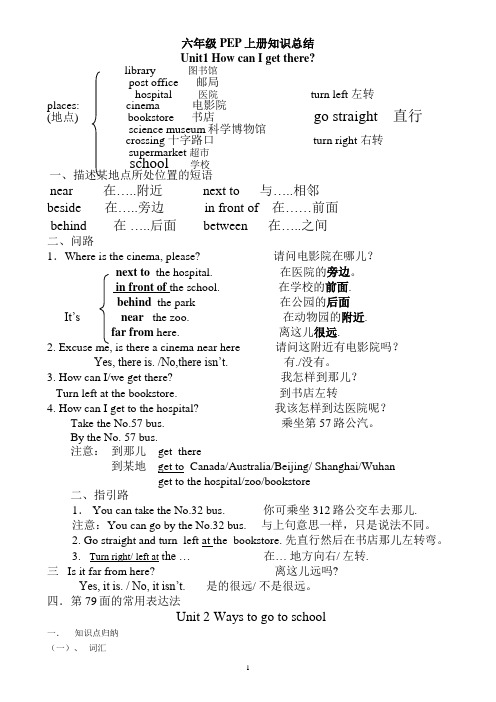
六年级PEP上册知识总结Unit1 How can I get there?library 图书馆post office 邮局hospital 医院turn left 左转places: cinema 电影院(地点) bookstore 书店go straight 直行science museum科学博物馆crossing 十字路口 turn right 右转supermarket 超市school 学校一、描述某地点所处位置的短语near 在…..附近 next to 与…..相邻beside 在…..旁边 in front of 在……前面behind 在…..后面 between 在…..之间二、问路1.Where is the cinema, please? 请问电影院在哪儿?next to the hospital. 在医院的旁边。
in front of the school. 在学校的前面.behind the park 在公园的后面It’s near the zoo. 在动物园的附近.far from here. 离这儿很远.2. Excuse me, is there a cinema near here 请问这附近有电影院吗?Yes, there is. /No,there isn’t. 有./没有。
3. How can I/we get there? 我怎样到那儿?Turn left at the bookstore. 到书店左转4. How can I get to the hospital? 我该怎样到达医院呢?Take the No.57 bus. 乘坐第57路公汽。
By the No. 57 bus.注意:到那儿 get there到某地 get to Canada/Australia/Beijing/ Shanghai/Wuhanget to the hospital/zoo/bookstore二、指引路1. You can take the No.32 bus. 你可乘坐312路公交车去那儿.注意:You can go by the No.32 bus. 与上句意思一样,只是说法不同。
(完整word版)pep六年级上册英语-各单元知识点总结
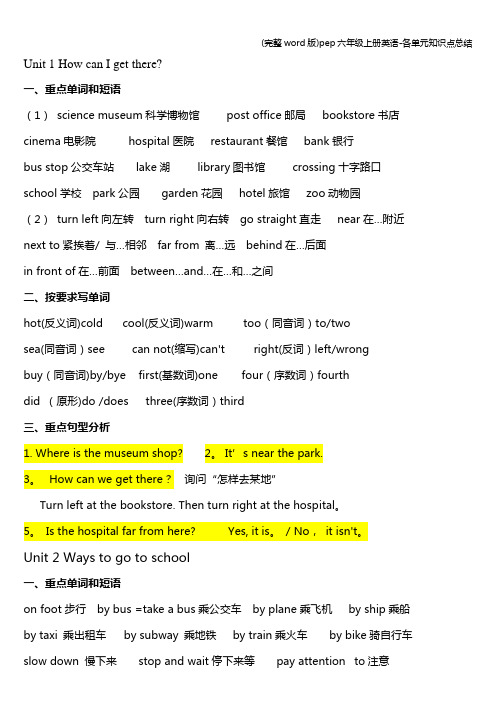
Unit 1 How can I get there?一、重点单词和短语(1)science museum科学博物馆post office邮局bookstore书店cinema电影院hospital医院restaurant餐馆bank银行bus stop公交车站lake湖library图书馆crossing十字路口school学校park公园garden花园hotel旅馆zoo动物园(2)turn left向左转turn right向右转go straight直走near在…附近next to紧挨着/ 与…相邻far from 离…远behind在…后面in front of在…前面between…and…在…和…之间二、按要求写单词hot(反义词)cold cool(反义词)warm too(同音词)to/twosea(同音词)see can not(缩写)can't right(反词)left/wrongbuy(同音词)by/bye first(基数词)one four(序数词)fourthdid (原形)do /does three(序数词)third三、重点句型分析1. Where is the museum shop? 2。
It’s near the park.3。
How can we get there?询问“怎样去某地”Turn left at the bookstore. Then turn right at the hospital。
5。
Is the hospital far from here? Yes, it is。
/ No,it isn't。
Unit 2 Ways to go to school一、重点单词和短语on foot步行by bus =take a bus乘公交车by plane乘飞机by ship乘船by taxi 乘出租车by subway 乘地铁by train乘火车by bike骑自行车slow down 慢下来stop and wait停下来等pay attention to注意cross the road横穿马路traffic light通信号灯at home在家look right向右看look at朝…看play with和…一起玩二、按要求写单词go (反义词)come foot(复数)feet child(复数)childrenearly(反义词)late good(反义词)bad take(反义词)bringslow(反义词)quick/fast go(过去式)went do(过去式)diddo(第三人称单数) does go(第三人称单数)goessame 相同的(反义词)different不同的miss(过去式)missedwrong 错误(反义词)right正确can(否定形式)can’t三、重点句型分析1。
(完整版)人教版(PEP)小学英语六年级上册复习资料
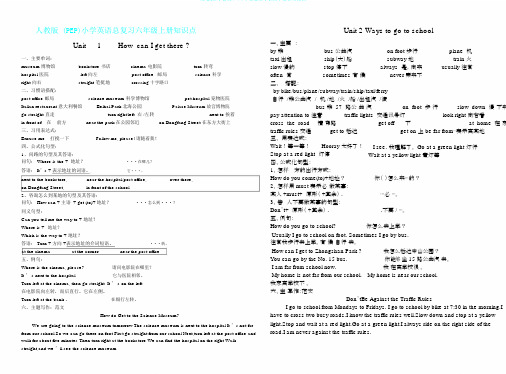
人教版 (PEP)小学英语总复习六年级上册知识点Unit1How can I get there ?一、主要单词:museum 博物馆bookstore 书店cinema 电影院turn 转弯hospital 医院left 向左post office邮局science 科学right 向右straight 笔挺地crossing 十字路口二、习惯语搭配:post office 邮局science museum 科学博物馆pet hospital 宠物医院Italian restaurant 意大利餐馆Beihai Park 北海公园Palace Museum 故宫博物院go straight 直走turn right/left 右 /左转next to 挨着in front of... 在 ...前方near the park 在公园邻近on Dongfang Street 在东方大街上三、习用表达式:Unit 2 Ways to go to school一、主要:by 乘bus 公共汽on foot 步行plane 机taxi 出租ship(大)船subway 地train 火slow 慢的stop 停下always 是,向来usually 往常often 常sometimes 有候never 素来不二、搭配:by bike/bus/plane/subway/train/ship/taxi/ferry自行 /乘公共汽 / 机 /地 /火 /船 /出租汽 /渡bus 乘 57 路公共汽on foot 步行slow down 慢下来pay attention to 注意traffic lights 交通讯号灯look right 向右看cross the road横穿路get off下at home 在家traffic rules 交通get to 抵达get on 上be far from⋯表示离某地Excuse me打搅一下Follow me, please! 请随着我!四、公式化句型:1、问路的句型及其答语:问句: Where is the + 地址?···在哪儿?答语: It’s + 表示地址的词语。
PEP小学英语六年级上册各单元知识点复习资料
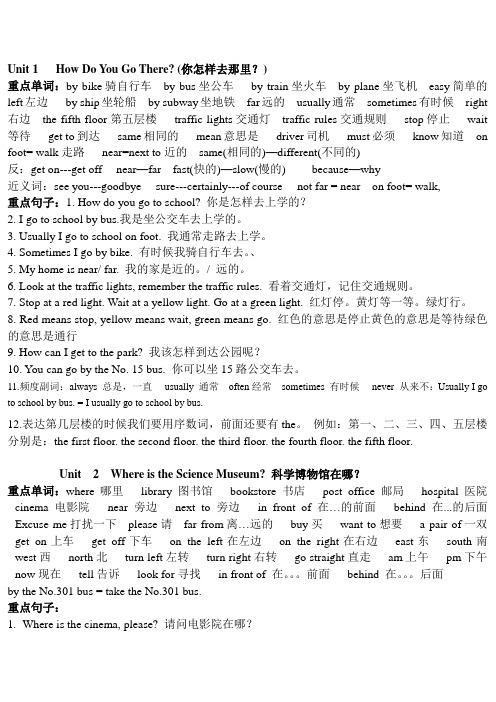
Unit 1 How Do Y ou Go There? (你怎样去那里?)重点单词:by bike骑自行车by bus坐公车by train坐火车by plane坐飞机easy简单的left左边by ship坐轮船by subway坐地铁far远的usually通常sometimes有时候right 右边the fifth floor第五层楼traffic lights交通灯traffic rules交通规则stop停止wait 等待get to到达same相同的mean意思是driver司机must必须know知道on foot= walk走路near=next to近的same(相同的)—different(不同的)反:get on---get off near—far fast(快的)—slow(慢的) because—why近义词:see you---goodbye sure---certainly---of course not far = near on foot= walk,重点句子:1. How do you go to school? 你是怎样去上学的?2. I go to school by bus.我是坐公交车去上学的。
3. Usually I go to school on foot. 我通常走路去上学。
4. Sometimes I go by bike. 有时候我骑自行车去。
、5. My home is near/ far. 我的家是近的。
/ 远的。
6. Look at the traffic lights, remember the traffic rules. 看着交通灯,记住交通规则。
7. Stop at a red light. Wait at a yellow light. Go at a green light. 红灯停。
黄灯等一等。
绿灯行。
8. Red means stop, yellow means wait, green means go. 红色的意思是停止黄色的意思是等待绿色的意思是通行9. How can I get to the park? 我该怎样到达公园呢?10. You can go by the No. 15 bus. 你可以坐15路公交车去。
- 1、下载文档前请自行甄别文档内容的完整性,平台不提供额外的编辑、内容补充、找答案等附加服务。
- 2、"仅部分预览"的文档,不可在线预览部分如存在完整性等问题,可反馈申请退款(可完整预览的文档不适用该条件!)。
- 3、如文档侵犯您的权益,请联系客服反馈,我们会尽快为您处理(人工客服工作时间:9:00-18:30)。
PEP小学英语六年级上册知识点归纳Unit 1 How can I get there?知识点归纳library 图书馆post office 邮局hospital 医院 turn left 左转 turn right 右转places: cinema 电影院( 地点) bookstore 书店science museum科学博物馆 go straight 直行pet hospital 宠物医院school 学校supermarket 超市 crossing 十字路口shoe store 鞋店Italian restaurant 意大利餐馆问路的重点句型:1.Where is the cinema, please? 请问电影院在哪儿?next to the bookstore 紧挨着书店in front of the school. 在学校的前面.behind the park 在公园的后面It’s near the zoo. 在动物园的附近.on D ongfang S treet 在东方大街上over there 在那边2. Excuse me, is there a cinema near here ?请问这附近有电影院吗?Yes, there is. /No,there isn’t. 有./没有。
3. How can I get to the hospital? 我该怎样到达医院呢?How can I / we get there?我/ 我们怎样到那?回答Turn right/ left at the … 在… 地方向右/ 左转.或Go straight 向前直走.或You can take the No.31 bus. 你可乘坐31路公交车去。
4. Is it far from here? 离这儿远吗?Yes, it is. / No, it isn’t.是的很远/ 不是很远。
Unit 2 Ways to go to school 一.知识点归纳(一)、词汇bike ( 自行车乘坐) slow down 慢下来公共汽车(脚) stop 停下来火车(怎样)飞机) go to school (上学)轮船) taxi 出租车 ferry 轮渡 sled 雪橇subway ( 地铁) (交通工具前加by ,表示乘坐,但步行要用on foot )(二)、重点句型①询问交通方式用疑问代词how⏹—— How do you go to school ? 你怎样去/来上学?—— I go to school on foot . 我走路去/来上学。
⏹—— How does your father go to work ? 你父亲怎样去上班?—— He goes to work by subway . 他坐地铁去上班。
②询问地点,用疑问代词whereWhere is your home ? 你家在哪里?It’s near the post office . 在邮局旁边。
Where are the teachers ? 老师们在哪儿They are in the teacher’s office .在老师的办公室。
③问路: How can I get to the F uxing H ospital? 我怎么去福星医院?You can take the No .1 bus . 你可以乘坐1路公交车。
④交通规则(traffic rules ):Stop and wait at a red light . 红灯停Go at a green light . 绿灯行Slow down and stop at a yellow light . 黄灯停⑤ You must drive slowly. You must wear a life jacket. You must stop at a red light. 你必须开慢点。
你必须穿救生衣。
你必须在红灯时停。
Don’t go at a red light. Don’t run on the ferry. Don’t let the dogs run too fast. 不要在红灯时走。
不要在轮渡上奔跑。
不要让狗跑的太快。
Unit 3 My weekend plan一、知识点归纳(一)、词汇四会 next week /weekend 下周/ 周末 newspaper 报纸this morning 今天上午漫画书Time this afternoon 今天下午 word book 单词书(时间 ) this evening 今天晚上 this weekend 这个周末 dictionary 字典tonight 今夜 tomorrow 明天 post card 明信片 take a trip 去旅游 theme park 主题公园activities see a film 看电影 others pet shop 宠物店(活动) go to the supermarket 去看电影(其他) supermarket 超市visit my grandparents 参观祖父母 shoe store 鞋店二、重点句式和句型:本单元中出现的一个重点语法是一般将来时:表示将要发生的动作或状态 ,常和表示将来的时间连用。
构成:主语 + be going to +动词原形+ 其他例子 I am going to (go to)the bookstore by bus this afternoon.He/ She is going to take a trip by train this weekend.We/ They are going to see a film tonight.特殊疑问词引导的句子:例子:What are you going to do this afternoon?Where are you go ing this afternoon?How are you going to the bookstore this afternoon?When are you going to the bookstore by bus?(以上特殊疑问句中are you 可以替换为is he , is she, are they, are we等)三、重点句型:1. we’re going to see a film about space trael! 我们将要去看关于火星之旅的电影。
2. We are going to draw some pictures in Renmin Park.我们打算去人民公园画一些画。
3. Have a good time!玩的愉快。
4. ----What are you going to do in the future? 你将来想干什么?----I’m going to be a science teacher one day.或I want to be a science teacher one day. 我想将来有一天当科学老师。
Unit 4 I have a pen pal本单元的重点是谈论某人的兴趣爱好,语法是动词的-ing形式和动词的第三人称单数形式。
一、词汇: dance (dancing) 跳舞sing (singing ) 唱歌hobb y play football (playing football) 踢足球(爱好) read story (reading stories ) 看故事hobb ies do kung fu (doing kung fu ) 练武术live (live s) in Shiyan 住在十堰 like (like s) 喜欢teach (teach es) English 教英语 study ( stud ies Chinese 学习汉语) go (go es) hiking 去远足 cook (cook s ) Chinese food 制作中国食物) 第三人单数 watch (watch es) TV 看电视read (read s) newspaper读报纸do (does) word puzzles 猜字谜二、句型:1.询问某人的兴趣爱好:①----What’s your hobby?(单数句式) What are your hobbies?(复数句式)你的爱好是什么?----I like reading stories and singing. 我喜欢读故事书和唱歌。
I also like…我也喜欢…② ---- What’s Peter’s (his) / Amy’s (her) hobby? (单数句式)What are Peter’s (his) / Amy’s (her) hobbies? (复数句式)---- He / She like s reading stories and singing. 他 / 她喜欢读故事书和唱歌。
2. 表示征求别人意见:Can I also be his pen pal? 我也可以做他的笔友吗? Sure.当然。
三、语法用法:(1)表达喜欢做某事,通常要用动词的-ing形式, 即:like do ing sth.如:like sing ing / playing football / listening to music / playing the pipa / watching TV等(2)一般现在时的用法表示经常或习惯性的动作或状态,常与every day /morning /evening ,often, usually, always,sometimes 等状语连用。
如: We do morning exercises every day. He usually goes to school by bike. (3)结构:①肯定句:主语+动词+其他。
如: Miss white teaches English.②否定句:主语+don’t/doesn’t +动词+其他如:Miss white doesn’t teach English.③一般疑问句:Do/ Does +主语+动词原形+其他?如: Does Miss White teach English?肯定、否定回答:Yes,she does ./ No, she doesn’t .备注:第三人称单数用does, doesn’t. 没有does,doesn’t 时动词必须要有变化。
四、语法记忆小锦囊★一般现在时用法记忆歌:肯定句的现在式,不是三单用原形,要是三单就加s,es,若是否定疑问句,没有be就加个do,碰到三单加does。
